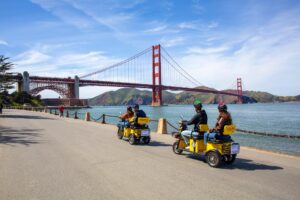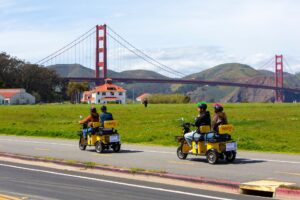Exploring the History and Current Status of San Francisco’s Municipal Pier and Aquatic Park
San Francisco’s Municipal Pier and Aquatic Park hold a rich history and a significant place in the city’s maritime heritage. This iconic location, part of the San Francisco Maritime National Historical Park, offers visitors a blend of history, natural beauty, and recreation. In this article, we’ll dive into the past, the present challenges, and exciting facts about the Municipal Pier and Aquatic Park.
A Historic Landmark by the Bay
The Aquatic Park Historic District is a National Historic Landmark situated along the picturesque San Francisco Bay waterfront. This district encompasses various elements, including a beach, a bathhouse, the famous Municipal Pier, restrooms, a concessions stand, stadia, and two speaker towers.
The Birth of the Maritime Museum
The San Francisco Maritime Museum, a centerpiece of the district, was originally constructed in 1936 as a bathhouse under the Works Progress Administration (WPA). The building’s streamline moderne style captivates visitors with its colorful murals, while the Steamship Room takes you on a journey through maritime technology’s evolution.
A Glimpse into History
Adjacent to the museum, a man-made lagoon now graces the site of the former Black Point Cove. To the west stands the iconic horseshoe-shaped Municipal Pier, an essential part of this historic district.
Recognition and Preservation
In 1987, the Aquatic Park Historic District was proudly designated a National Historic Landmark, solidifying its place in American history. Additionally, it was added to the National Register of Historic Places in 1984.
The Present: Closure and Rebuilding Effort
While the history of Municipal Pier and Aquatic Park is fascinating, the present tells a different story. The Municipal Pier, also known as “Muni” pier, was a beloved destination until its closure in October 2022 due to structural damage resulting from an earthquake.
Muni Pier’s Purpose
Built in 1933, the Municipal Pier was intended to create a safe cove for San Francisco residents to enjoy swimming and recreation. It served as a vital pedestrian access point into the bay while also functioning as a tidal energy dampener.
Structural Challenges
Years of battling winter storms, pounding waves, and seismic activity have taken a toll on this 1400-foot walkway over San Francisco Bay. Despite its closure to pedestrians, the pier still plays a role in preserving the Aquatic Park National Historic Landmark District.
The Baffle System
Notably, the pier incorporated an innovative baffle system designed to mitigate the bay’s currents’ effects on Aquatic Park Cove. These baffles serve as a breakwater and have seen the addition of riprap over time to protect against scouring.
A Piece of San Francisco’s Maritime Heritage
Municipal Pier has a unique curvilinear design, featuring a concrete deck road supported by reinforced concrete and jacketed wood pilings. Benches and streetlights adorn its length, offering a perfect spot for fishing or simply enjoying the bay views.
Permanent Closure and Reconstruction Challenges
Municipal Pier is now closed permanently, as preserving the existing structure is deemed unfeasible. Rebuilding it from scratch is a complex endeavor, with estimated costs likely exceeding $100 million.
9 Fun and Interesting Facts about Municipal Pier
- Black Point’s Evolution: Black Point Cove was originally called Punta Medanos by Spanish settlers but was later renamed Black Point after 1849.
- Early Bathhouses: In the late 1800s, Black Point Beach was a popular swimming destination with numerous bathhouses along the water’s edge.
- Sea Water Health Craze: During the mid-1880s, seawater swimming was all the rage, with saltwater spas providing over 300 bathing cabins along Black Point Beach.
- Aquatic Park’s Origins: Aquatic Park Cove was completed in 1933, transforming the once-popular swimming area into its current state.
- Maritime Museum’s Beginnings: The San Francisco Maritime Museum, now known for its maritime exhibits, started as a bathhouse.
- Curvilinear Design: Municipal Pier’s unique design features a round bulb-like end, making it an iconic part of San Francisco’s waterfront.
- Military Collisions: The pier experienced severe structural damage twice during its history due to collisions with a U.S. Army tug and a freighter.
- Public Safety Closure: The closure of Municipal Pier in 2022 was due to structural damage from an earthquake, deemed unsafe for public use.
- Historical Significance: The pier’s preservation is crucial, as its collapse could jeopardize the Aquatic Park National Historic Landmark District and historic ships nearby.
Looking to the Future
The National Park Service remains committed to monitoring the pier’s condition. While the future of Municipal Pier is uncertain, planning for its potential reconstruction is underway. This iconic landmark continues to be an integral part of San Francisco’s maritime history, and efforts to preserve its legacy persist.
So, while we may not be strolling along the Municipal Pier today, its history and the promise of its potential revival continue to captivate those who appreciate San Francisco’s unique blend of heritage and natural beauty.







